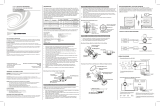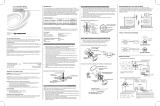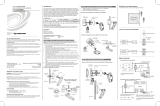
LIMITED 5 YEAR WARRANTY AND EXCLUSIONS
Leviton warrants to the original consumer purchaser and not for the benefit of anyone else that this product at the time of its sale by Leviton is free of defects in materials and workmanship under normal and proper use for five years from the purchase date. Leviton’s only obligation is to correct such defects by repair or replacement, at its option, if within such five year period the product is returned prepaid, with proof of purchase date, and a description of the
problem to Leviton Manufacturing Co., Inc., Att: Quality Assurance Department, 59-25 Little Neck Parkway, Little Neck, New York 11362-2591. This warranty excludes and there is disclaimed liability for labor for removal of this product or reinstallation. This warranty is void if this product is installed improperly or in an improper environment, overloaded, misused, opened, abused, or altered in any manner, or is not used under normal operating conditions
or not in accordance with any labels or instructions. There are no other or implied warranties of any kind, including merchantability and fitness for a particular purpose, but if any implied warranty is required by the applicable jurisdiction, the duration of any such implied warranty, including merchantability and fitness for a particular purpose, is limited to five years. Leviton is not liable for incidental, indirect, special, or consequential damages,
including without limitation, damage to, or loss of use of, any equipment, lost sales or profits or delay or failure to perform this warranty obligation. The remedies provided herein are the exclusive remedies under this warranty, whether based on contract, tort or otherwise.
PK-93586-10-00-0A
OPERATION
• Multi-Tech Mode – This is the default mode of operation for the sensor. PIR
technology turns lights on in this mode; however, motion detection by either
technology will keep the lights on. If neither technology detects motion, the lights
turn off after the delayed-off time.
• Single-Tech Mode – Only one technology is active in this mode. The technology is
selected by the dip switches. Motion detection by the selected technology - PIR or
ultrasonic - will turn on the lights as well as keep them on. When motion is not
detected, the lights will turn off after the delayed-off time.
• Delayed-Off time – The sensor is designed to turn the lights off if no motion is
detected after a specified time. This length of time is called the delayed-off time and
is set using the timer (Black) knob on the sensor. The adapting patterns will modify
the delayed-off time to fit the parameters of each installation based on environmen-
tal conditions and occupancy patterns.
•Walk-through Mode – The walk-through feature is useful when a room is momen-
tarily occupied. With this feature, the sensor will turn the lights off shortly after the
person leaves the room.
The walk-through feature works as follows: When a person enters the room, the
lights will turn on. If the person leaves the room before the default walk-through time-
out of 2.5 minutes, the sensor will turn the lights off. If the person stays in the room
for longer than 2.5 minutes, the sensor will proceed to the standard operation.
• LED Operation – There are two LED indicators that will flash when motion is
detected. The LED flash can be disabled using the LED disable switch setting. Green
flash indicates motion detection by ultrasonic technology. Red flash indicates motion
detection by infrared technology.
ADAPTIVE FUNCTIONS
The Sensor continually analyzes the parameters of the motion detection signal and
adjusts its internal operation to maximize detection of motion while minimizing the
effects of noise (electrical noise, air currents, temperature changes, etc…).
Operation:
When the lights turn on, the sensor initially enters the “walk-through” mode. Once the
room is occupied for longer than 2.5 minutes, the sensor exits the “walk-through” mode
and enters the “Occupied” mode. When the sensor is first installed, the delayed-off
time for the occupied mode is based on the Time adjustment settings. While the sensor
is in use, the delayed-off time will change, based on how the sensor adapts to the room
conditions. Whenever the sensor subsequently turns on, the value of the delayed-off
time will be the
adapted
value (refer to Occupancy Pattern Learning For Delayed
Off Time).
The adapted settings can be reset using the DIP switch.
Occupancy Pattern Learning For Delayed Off Time:
The sensor will automatically change the delayed off time in response to the occupancy
and environmental conditions of the space it is installed in. The sensor analyzes the
motion signal properties and will minimize the delayed off time duration when there is
frequent motion detection, and lengthen the delayed off time duration when there is
weak and infrequent motion detection.
In the case of a false-off condition (lights turn off when the room is occupied), the
delayed off time duration will immediately be lengthened to prevent further false turn
offs.
Occupancy Pattern Learning for Ultrasonic Technology:
The sensor learns the occupancy patterns of a space during the course of a day, for a
seven day period. At any given time, the sensor will look at the collected data and
adjust its ultrasonic sensitivity. The sensor will adjust the sensitivity to make it less likely
to turn on during a period of non-occupancy and more likely to turn on during a period
of occupancy. This adapting feature is not applicable when the sensor is in PIR only
mode.
SETTINGS
Default Settings:
Adjustment knob settings as per “recommended manual settings,” (refer to Table 3 and
Figure 1).
All switches in the off position (refer to Table 4).
Test Mode: To set the delayed-off time to 6 seconds for performing a walk test. While
the sensor is in test mode, the LED’s will flash amber once a second.
1. ENSURE POWER IS ON.
2. Remove front cover.
3. Locate Dip Switch 3 in Bank B (B3) (refer to Figure 1). B3 will be in the OFF
position from the factory.
4. To enter Test Mode, move switch to ON and back to OFF. The test mode has now
been entered with a 6 second time-out. NOTE: If B3 is already in the ON position,
then test mode can be entered by just moving it to the OFF position.
NOTES:
1. The timer will remain in the 6 second test mode for 15 minutes, then automatically
exit test mode and reset to the delayed-off time setting as defined by the black timer
knob.
2. To manually take the timer out of the 6 second test mode, simply toggle the switch
B3 from OFF to ON and back to OFF.
Photocell (Ambient Light Override) adjustment:
In order to use the Ambient Light Override functionality of the sensor, the sensor must
be wired to the power pack (OSP
XX
) using the gray wire instead of the blue wire. This
feature allows the user to conserve energy by keeping the controlled lights off when not
necessary. The sensor does this by measuring the amount of ambient light in the
installed area and keeping the controlled lights off if there is enough ambient light
available. To use this feature, the Photocell adjustment (blue) knob must be adjusted
from the default position. Once this adjustment is made, the controlled lights will only
turn on if the ambient light present is less than the setting.
To set the Photocell level (used with the gray wire connection):
NOTE: This setting must be performed when the natural light is low enough to require
artificial light.
1. Remove the cover from the sensor.
2. Make note of the position of the Red and Green knobs. Rotate the Red and Green
knobs full CCW and enter the sensor’s Test mode as described above.
3. Rotate the Blue knob full CCW.
4. Wait for the lights to turn OFF.
5. Rotate the Red knob full CW.
6. Slowly rotate the blue knob clockwise until the lights turn ON. This is the correct
setting.
7. Return the Red and Green knobs to their original positions.
8. Replace cover. Setting is complete.
A
B
ON ON
11
A
B
ON ON
11
TROUBLESHOOTING
• Lights do not turn ON
- Circuit breaker or fuse has tripped.
- Low-voltage miswired. To Test: Connect RED to BLUE wire at power pack to force
lights ON.
- Line voltage miswired. To Test: Connect BLUE to BLUE relay wires (of power pack)
to force the lights ON.
• Lights stay ON
- Constant motion. To Test: Reduce RED and/or GREEN knob by 15%; remove
motion source. If unsatisfactory, move sensor.
- Infrared sensor can "see" into hallway. To Test: Put sensor in timer test mode walk
and walk hallway. If lights continue to come ON, move sensor.
• Light turns ON too long
- Timer setting too high. To Test: Check switch settings. Typical setting is 10 minutes.
PRODUCT INFORMATION
•For technical assistance, contact us at
1-800-824-3005
• Visit our website at
www.leviton.com
Figure 1
Minimum and Default Settings
Minimum Setting
Factory Default Setting
MIN
MA
Adjust Knob Rotation Direction
0
20
11.5
11.5
8.5
8.5
20
TOP VIEW
SIDE VIEW
0
20
2317
11
15
5.6
9
3
8
0
Minor Motion, Ultrasonic
Major Motion, Ultrasonic
Major Motion, IR
Figure 2 (Cat. No. OSC05)
Field-of-View Ranges
Figure 3 (Cat. No. OSC10)
Field-of-View Ranges
0
20
11.5
11.5
8.5
8.5
20
SIDE VIEW
TOP VIEW
2323 1717
8
0
111115 1520 2099 33 0 5.65.6
Minor Motion, Ultrasonic
Major Motion, Ultrasonic
Major Motion, IR
0
20
8
16
16
11.5
11.5
20
SIDE VIEW
TOP VIEW
0335.5 5.59911 1115 1520 20
32 3222.5 22.5
Minor Motion, Ultrasonic
Major Motion, Ultrasonic
Major Motion, IR
Figure 4 (Cat. No. OSC20)
Field-of-View Ranges
By masking two sections,
you can block hallway traffic
Masking is not required in a corner
mounting application. The sensor
can not see hallway traffic.
Mask
Mounting Location Diagram
DIP Switches
30 sec
5 min
30 min
20 min
10 min
Delayed Off Time Selection (Black Knob)
TABLE 3: ADJUSTMENT KNOB SETTINGS
Knob
Color
Function
Sets the ultrasonic range
Sets the infrared range
Delayed- Off Time
Ambient Light Override
(Gray wire only)
Knob Setting
Range setting
Full CCW = min. (OFF)
Full CW = max.
Range setting
Full CCW = min. (OFF)
Full CW = max.
Full CCW = min. (30 sec.)
Full CW = max. (30 min.)
Factory Default
Setting
75%
50%
100%
Full CCW – Lights stay OFF
Full CW – Lights always turn ON
(NO ambient light override)
Range – 100-3000 LUX
50%
(10 min)
Blue
Black
Red
Green
Symbol
SWITCH FUNCTIONS
Bank A OFF ON
Single/Multi-Tech Mode Multi-Tech Single Tech
PIR/Ultrasonic Mode PIR Ultrasonic
Manual Mode Auto Adapting Enabled Auto Adapting Disabled
Walk-Through Disable Walk-Through Enable Walk-Through Disable
Bank B
Override to ON Auto Mode Lights Forced ON
Override to OFF Auto Mode Lights Forced OFF
Test Mode OFF ON OFF = Enter/Exit Test Mode
LEDs Disable LEDs Enabled LEDs Disable
TABLE 4: SWITCH SETTINGS
SWITCH SETTINGS
SWITCH
A1
A2*
A3
A4
B1
B2
B3
B4
B3
*NOTE: This setting is only used if the Single Technology Option (switch A1) is
selected.




